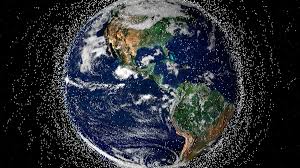
Space Junk Crisis: Is Earth’s Orbit Getting Too Crowded?
Look up at the night sky, and you see stars and satellites twinkling above. But hidden in that same orbit is a growing menace: space junk—thousands of pieces of debris hurtling around Earth at breakneck speeds.
Is our planet’s orbit becoming too crowded? And could this “space junk” threaten not only satellites and astronauts but also the future of space exploration?
Also check for : nuclear-fusion-breakthrough-infinite-energy-at-last
☄️ What Exactly Is Space Junk?
Space junk, or orbital debris, includes defunct satellites, spent rocket stages, fragments from collisions, and tiny paint flakes. Unlike falling leaves, this debris travels at speeds up to 17,500 mph—fast enough to damage or destroy functioning spacecraft.
Since the dawn of the space age in the 1950s, humanity has launched over 13,000 satellites—with many now retired or broken, adding to the clutter.
🚨 Why Is Space Junk a Problem?
-
Collision Risk: Space junk can collide with active satellites, creating more debris in a dangerous chain reaction known as the Kessler Syndrome.
-
Threat to Space Missions: Even small debris can puncture the International Space Station or damage expensive spacecraft.
-
Interference with Services: Damaged satellites can disrupt GPS, weather monitoring, communication, and scientific research.
-
Costly Repairs and Delays: Agencies must spend billions shielding equipment or avoiding debris paths.
🌐 How Crowded Is Earth’s Orbit?
Low Earth Orbit (LEO), where many satellites and the ISS reside, is the most congested. There are over 34,000 tracked objects larger than 10 cm, and hundreds of thousands more too small to track, yet dangerous.
The problem is accelerating—mega-constellations like Starlink plan to launch tens of thousands of new satellites for internet access, adding to the congestion.
🧹 Cleaning Up Space Junk: What’s Being Done?
Several innovative solutions are being explored:
-
Space Tugs: Satellites equipped with robotic arms or nets to capture and deorbit debris.
-
Lasers: Ground-based lasers aimed at pushing small debris out of orbit.
-
Electrodynamic Tethers: Using electromagnetic forces to drag junk into Earth’s atmosphere to burn up.
-
Regulations: New international laws aim to limit debris and require satellite operators to safely deorbit their craft after use.
NASA, ESA, and private companies are racing to develop effective cleanup tech, but challenges remain.
⚠️ Why It Matters to You
We rely on satellites daily—for weather forecasts, navigation, banking, and internet. A growing debris field threatens these lifelines.
Worse, as space tourism and lunar missions ramp up, the need for a clean, safe orbit is more urgent than ever.
🚀 The Future of Space: Can We Keep It Clean?
Protecting Earth’s orbit requires global cooperation, innovation, and strict regulation. It’s a new frontier of environmental responsibility.
If we fail, the space junk crisis could ground satellites and delay humanity’s push deeper into the cosmos.
But with smart solutions and commitment, we can keep space safe—for our planet and generations to come.
🧠 Final Thought
Earth’s orbit is the busiest highway in space—and it’s getting dangerously crowded. The space junk crisis is real, urgent, and affects everyone on the ground.
Our future in space depends on how well we manage this orbital mess today.